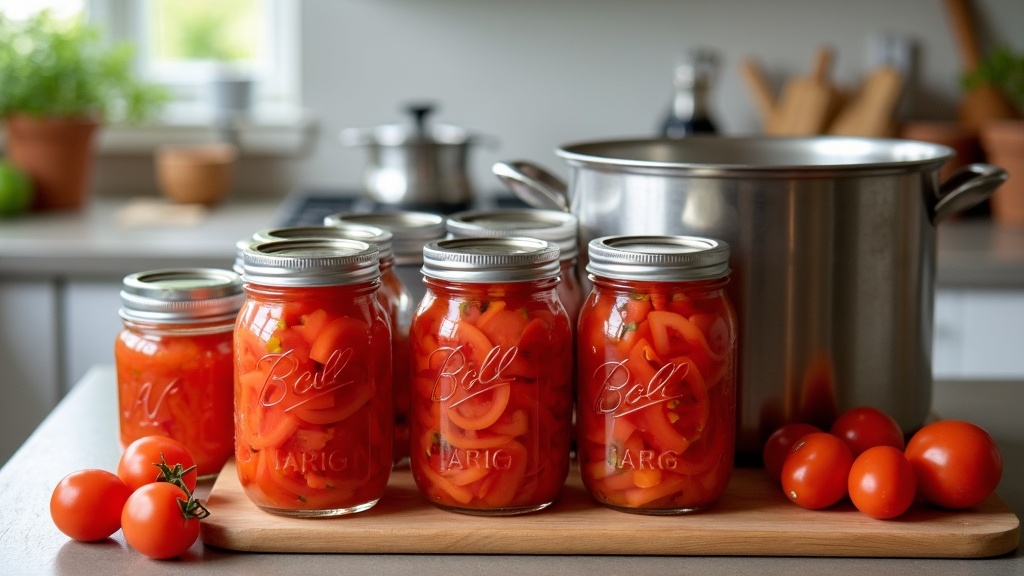
Canning tomatoes in a water bath offers a practical way to preserve fresh flavors for use all year round. I’ve found it to be a super satisfying process, and it lets me stock up my pantry with homemade goodness that’s far tastier than anything from the store. If you’re new to canning, it might feel a little intimidating at first, but once you’ve followed the steps a couple of times, you’ll feel like a pro. I’ve put together everything you’ll need to know for water bath canning tomatoes, so you can skip the guesswork and get straight to the tasty results.
Gathering Your Tomato Canning Supplies
Having the right tools makes canning tomatoes go a lot smoother. Not every gadget on the market is necessary, but a solid setup saves time and reduces spills. Here are the basics I always lay out on my kitchen counter:
- Large pot: For blanching and peeling the tomatoes. You can’t skip this step for the best texture.
- Water bath canner or tall stockpot: Must be deep enough to cover jars by at least 1 inch of water.
- Canning jars, lids, and bands: I stick with pint or quart mason jars. Always use new lids for a good seal.
- Jar lifter: Picking up hot jars out of boiling water calls for a special tool for safety.
- Funnel and ladle: These make packing your jars quicker and much less messy.
- Bubble remover or plastic spatula: Pretty handy for getting trapped air out of the jar.
It’s also smart to have clean towels, a timer, and a bowl of ice water for peeling your tomatoes quickly and neatly.
Amazon has a great selection of starter kits that include most of what you need to get started. Check them out here:
Canning Supplies Starter Kit
Picking and Prepping Tomatoes for Canning
Great canned tomatoes start with top-quality, ripe tomatoes. I like using Roma or paste types because they’re meatier and less watery, but just about any variety will do as long as they’re fresh and firm. Avoid tomatoes that are overripe or bruised, since they tend to fall apart when jarred and won’t hold their shape.
I usually wash, core, and etch with the knife an X on the bottom of each tomato before blanching. Drop them in boiling water for around 30-60 seconds, then transfer them to an ice bath. The skins come off much easier this way. After peeling, cut them into quarters or halves, or keep them whole. Pack them closely but gently into your sterilized jars. Don’t crush them too tight; leaving some room helps the juice circulate for even heating.
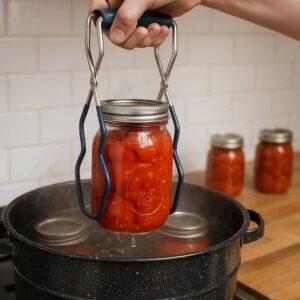
Step-by-Step Guide: Water Bath Canning Tomatoes
- Sterilize your jars: Wash jars and bands with hot soapy water, then let them simmer in the canner for several minutes or put them in a low oven. Keep lids hot, but never let them boil.
- Get your canner ready: Begin heating water. Make sure you have enough water to completely cover the jars by an inch or two.
- Add acid to each jar: This part is absolutely crucial for food safety. For each pint, use 1 tablespoon bottled lemon juice (2 tablespoons for quarts) before filling with tomatoes. Bottled lemon juice has consistent acidity, which makes the process safer.
- Pack jars: Place peeled tomatoes into the jars, packing them in gently. If needed, pour in hot tomato juice or water to fill in the gaps, leaving about 1/2 inch of headspace at the top.
- Remove bubbles and clean: Take a spatula or bubble remover and slide it along the inside of the jar to release trapped air. Wipe the rim with a clean, damp towel for a good seal.
- Seal and load: Put the lid on and screw the band down until it’s just fingertip-tight. Use your jar lifter to place jars into the hot canner.
- Process: When the water is boiling, start the timer: pints take 40 minutes, and quarts take 45 minutes. If you live over 1,000 feet above sea level, adjust the processing time according to local guidelines.
- Cool jars: Turn off the heat. Leave jars in the water for 5 minutes, then move them to a towel-lined counter. Jars should make a “ping” as they seal. Allow them to cool for at least 12 hours before testing the seal or storing.
Once cooled, label the jars and stash them in a cool, dark spot. Any jars that didn’t seal should be refrigerated and eaten within a week.
Safety Tips and Common Questions About Tomato Canning
Why is acid added, and do I really need lemon juice?
Homegrown tomatoes generally don’t have enough acid for safe canning, so adding lemon juice raises the acidity to help keep dangerous bacteria out. Always use bottled lemon juice or citric acid for best results. This step isn’t optional for shelf-stable tomatoes. If the flavor seems too tart, stir in a pinch of sugar to each jar to balance it out.
How do I can tomatoes the old-fashioned way?
Traditional tomato canning often skipped the acid, but up-to-date advice stresses that you should always add it for safety. The method is similar otherwise—peeling, packing, and boiling—the key today is sticking with the acid and recommended processing times. Historical methods often called for longer boiling, but that’s not as safe as using lemon juice and following modern timing.
How long do you water bath can tomatoes?
Here’s the correct timing for tomatoes packed in their juice:
- Pint jars: 40 minutes in a boiling water bath.
- Quart jars: 45 minutes in a boiling water bath.
If you’re at a higher altitude, increase the processing time accordingly. For the most accurate info, check trusted sources like the National Center for Home Food Preservation.
What if you forgot to add lemon juice?
If you missed the acid, those jars aren’t safe for room-temperature storage. Refrigerate them immediately and use them within a few days, or freeze them. Sadly, you can’t safely fix the acid level after the jars are sealed and processed.
Is water bath canning better or should I use a pressure canner?
Water bath canning is best for tomatoes with added acid. If you don’t want to add lemon juice or plan to include other low-acid foods, then pressure canning is safer. For just plain tomatoes (with bottled lemon juice), water bath canning is simple and keeps the flavor and texture familiar. Using a pressure canner is a fine option as well, though it’s usually not required when following tested recipes.
How long do tomatoes stay in the canner after turning off the heat?
I always let the jars sit in the canner with the heat off and the lid on for 5 minutes before moving them to cool. This helps prevent liquid from spilling out of the jars and improves the likelihood of all your jars sealing well.
Extra Tips for Home Canners
- Tomato variety: Go for paste tomatoes like Roma or San Marzano for easier peeling and less water inside the jar.
- Headspace: Leave about 1/2 inch at the top of your jars to prevent mess and make sure the jars seal well. Don’t cram them too tight; gentle packing works best.
- Removing skins: Always peel your tomatoes for better safety and texture, since bacteria can hide in the skins.
- Tools matter: If you’ll be canning often, a jar lifter and rack are great investments for protecting both your hands and your jars from burns or breaks.
Frequently Asked Questions
I hear these questions from canning friends and neighbors all the time, so here are a few more tips to keep your canning adventure smooth:
Q: Can I add herbs or garlic to my jars?
You can add a little bit of fresh or dried herbs or garlic, but don’t go overboard. Never add oil to the jars, as it lowers the acid and could make things unsafe. Stick to tested recipes or add extra flavor after opening the jar.
Q: Can I use a dishwasher to sterilize jars?
Dishwashers do a fine job cleaning jars, but for true sterilization, heat them in boiling water for at least 10 minutes or keep them hot in a low oven. Always keep jars hot before packing, and avoid filling a cold jar with hot tomatoes to prevent jar breakage.
Q: Can I reuse lids?
No. Always use fresh lids each time you can, since using old ones can lead to seal failures. The sealing material on canning lids is made for a single use.
Last Thoughts on Water Bath Canning Tomatoes
Water bath canning tomatoes is straightforward, fun, and can really become addictive over time. There’s a special kind of satisfaction in seeing bright red jars stacked neatly on your shelf, knowing you made them yourself. With just a few inexpensive tools, careful steps, and always adding lemon juice for safety, you’ll be set to enjoy the taste of summer tomatoes in sauces, stews, soups, and more long after the growing season has ended. Taste the reward of your efforts on a cold winter night—you’ll be glad you did.
© 2025, Teresa. All rights reserved.






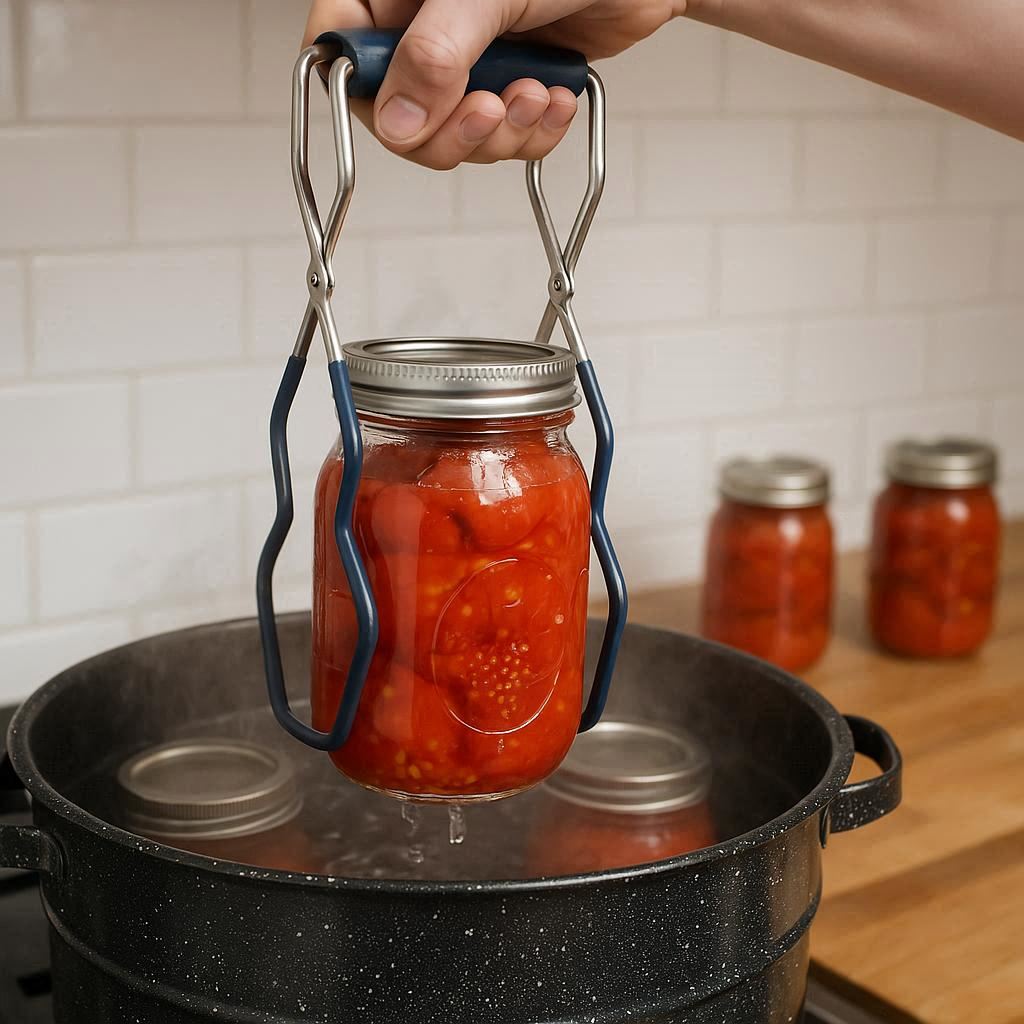
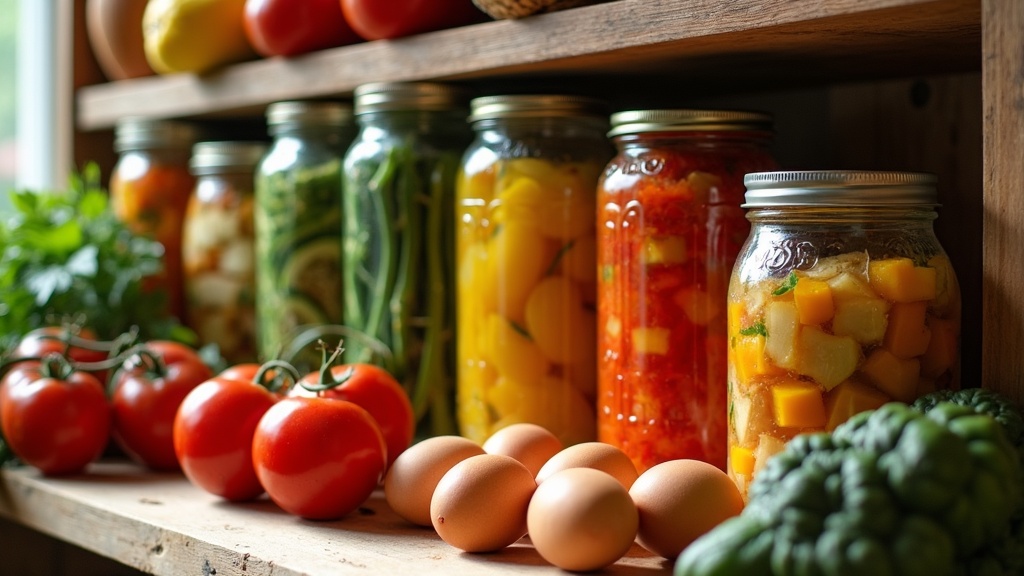
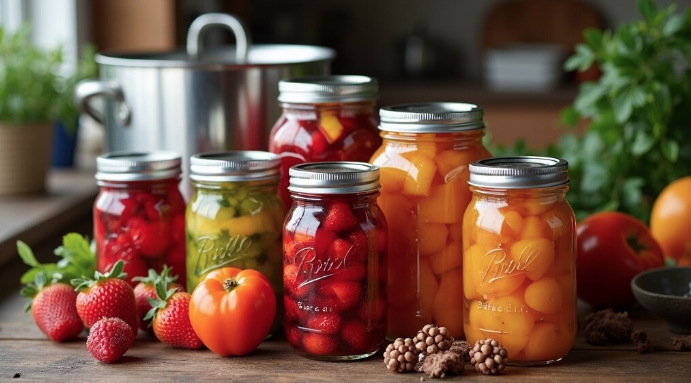
First off, I love your website. Very well done! Cool category ‘names’ and emojis. I’ve bookmarked your site for reference 🙂
I’m very interested in this subject, having two survival prepping sites. I’ve wanted to can tomatoes from my own garden, but I didn’t have enough. Too hot this year. I don’t really want to take the time to do all of the work on store-bought or produce-stand tomatoes, but your recipe is so well laid out that it’s tempting to do it anyway.
Thanks for the water-bath process! I had planned to use my pressure cooker, but this looks much easier. Can I use lime juice in a bottle, or does it have to be lemon? Which size jar, pint or quart, works the best for this?
Looks like I will be planting Roma tomatoes next year. I had tried heirloom and cherry. The cherry did great and a few more are still coming in. I’ve left them in their pots.
Teri
Thank you so much for your kind words! I’m glad you found the recipe and process easy to follow — that makes me happy to hear ????
For canning tomatoes, you can use either bottled lemon juice or bottled lime juice — both are safe and USDA-approved for acidity. Just avoid fresh juice, since the acidity can vary.
As for jar size, both pints and quarts work well — it really comes down to how much you’ll use at a time. Pints are great for smaller meals or sauces, while quarts are handy if you go through a lot of tomatoes at once.
Roma tomatoes are definitely a good choice for next year — they’re meaty and perfect for canning. Heirlooms and cherries are delicious fresh, but as you noticed, they’re a bit more work for preserving.
Sounds like you’ve got a great garden going already. I’d love to hear how your canning turns out when you try it!
It’ll be next year, so I may not remember to tell you, lol. I’m enjoying your site in the meantime 🙂
Thanks 😎🥰